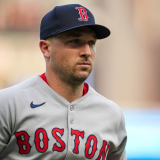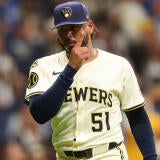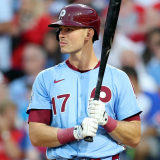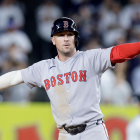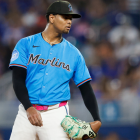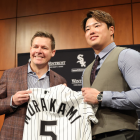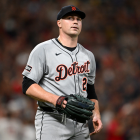MLB Prospect Watch: Cardinals lefty, Red Sox slugger among five biggest minor-league surprises in 2024
With the minor-league season wrapping up, here are some of the biggest jumps

September isn't just the final month of the Major League Baseball season -- it's also the final month of the Minor League Baseball campaign. With that in mind, we're using this and next week's Prospect Watch to sum up the year that was on the farm by highlighting some of the biggest individual surprises and disappointments.
For this edition, we'll focus on the surprises: the players who had better years than we anticipated, thereby improving their prospect status. Next week, we'll touch on the inverse: the players who fared worse than we forecasted heading into the season.
Before we get to matters, bear in mind that there were more than five compelling candidates for this piece. We tried to mix profiles to make for a more interesting read, too. In other words, it's nothing personal if your favorite breakout prospect wasn't included. (Also note that the players are presented in alphabetical order.)
Now, let's get to it.
1. Moisés Ballesteros, C/1B, Cubs
We left Ballesteros off the Cubs' top prospects list last winter for two reasons: 1) we preferred at least three of his system mates; and 2) we wanted to see him hit at the Double-A level. The first part is self-explanatory; as for the second part, it's because of our worry with his defensive profile and the chance he ends up at the cold corner.
Make no mistake about it: Ballesteros, 20, is going to be a bat-first backstop for however long he remains a catcher. He's not terrible back there, but he's also never going to compete for a Gold Glove Award. The bigger potential issue, so far as evaluators are concerned, is that he's built similarly to Dioner Navarro, Brayan Peña, and Alejandro Kirk (among others), and that it may eventually cause him to move off the position. Will that threat ever actually materialize? Truthfully, we have no idea.
Moises Ballesteros hits a no-doubter to straightaway center 🎯
— MLB Pipeline (@MLBPipeline) September 1, 2024
The @Cubs' No. 4 prospect -- the third-youngest player at Triple-A -- drills his 18th homer of the year, 9th for the @IowaCubs. pic.twitter.com/vC9mjGnNEp
Ballesteros made it less of an issue for us this season by continuing to demonstrate his offensive competency at the highest minor league levels. He has some swing and miss and some chase in his game, of course, but he's always walked and he's mostly kept his strikeout rate below 20%. Ballesteros has hit several balls over 109 mph, too, confirming that there's above-average juice in his left-handed bat.
Factor in Ballesteros' youth (he'll turn 21 in early November), and you have the makings of an above-average offensive player who should at least begin his career in the squat. That's a good prospect, and one who ought to debut early in 2025.
2. Kristian Campbell, MIF/CF, Red Sox
We wrote about Campbell in mid-August, but we felt that he merited inclusion in this piece as well for posterity's sake. We'll keep it brief all the same.
Kristian Campbell home runs hit different. Literally.
— Red Sox Player Development (@RedSoxPlayerDev) August 28, 2024
The 22-year-old outfielder's third HR in just six Triple-A games travelled 431 feet with an exit velocity of 108.3 mph. pic.twitter.com/66S6K893o6
Campbell, 22, has raised his stock since being drafted in the fourth round in 2023 by improving his bat speed. Those gains have unlocked added juice, to the extent that he's now able to clear the fence from pole to pole. Campbell also has a patient approach and a good feel for making contact, and he's a speedy runner with defensive experience just about everywhere on the diamond, making him something of a manager's delight.
It seems plausible to us that Campbell will make his big-league debut before the year is out. If not, expect him to make it to The Show before next Flag Day.
3. Jaison Chourio, OF, Guardians
Jackson's little brother saw his season end prematurely in late August after fracturing his wrist on a diving catch attempt. That made for a disappointing conclusion to an otherwise encouraging age-19 campaign.
AL is on the board!
— MLB Pipeline (@MLBPipeline) July 13, 2024
Jaison Chourio, the @CleGuardians' No. 3 prospect and brother of big leaguer Jackson, drives in Spencer Jones. pic.twitter.com/znf71SKON0
This Chourio isn't as toolsy as his more famous brother, and he's likely to slide into a corner spot on a permanent basis heading forward. Still, he's a switch-hitter who has shown a solid foundation of offensive skills. To wit, he walked more than he struck out this season in A-ball, and did so while showing improved abilities to lift and pull the ball -- two shifts that explain his career-best .129 ISO.
Chourio will need to continue to improve upon his slugging if he's going to make the most of his starting promise. For now, though, the arrow is pointing upward.
4. George Klassen, RHP, Angels
You may recall Klassen's story from the deadline trade that sent Carlos Estévez to the Phillies. If not: he's a former sixth-round pick by way of the University of Minnesota who walked nearly a batter per inning as a collegiate. The Phillies helped Klassen throw more strikes as a professional. His walk rate has swelled again since the deal, and he's walked more than a batter per inning through his first four Double-A starts. (He also had to leave a game after taking a bouncing batted ball to the face.)
Klassen's ability to get in the zone more frequently heading forward will determine his ultimate role -- you'd be justified to mentally clock him as a reliever until proven wrong. He has the kind of big-time stuff (including a hot fastball and some swing-and-miss breakers) that should enable him to be a high-leverage arm if the transition to the bullpen comes to pass.
Normally, we would estimate that Klassen is another year away from reaching The Show. This being the Angels, that may prove to be ultra conservative.
5. Quinn Mathews, LHP, Cardinals
Mathews is best known for throwing a 156-pitch complete game last summer during a postseason start for Stanford. St. Louis drafted him in the fourth round and subsequently shut him down for the season. They've since been rewarded with a quick ascent through the minor leagues that now has him stationed a call away in Triple-A.
Quinn Mathews: mind-melting backdoor changeup pic.twitter.com/FgSjWXWUOh
— Springfield Cardinals (@Sgf_Cardinals) August 24, 2024
Mathews has a varied arsenal that includes two mid-90s fastballs, a pair of breaking balls, and a changeup that stands out as his breadwinner. There's enough stuff and location here to envision him becoming a potential mid-rotation starter.
The 23-year-old recently set a new personal high in innings pitched, exceeding the 124 frames he threw last year for the Cardinal. We're skeptical these Red Birds will let him go far enough beyond that for him to factor into the big-league equation before the season ends. We do think he'll slot into their rotation sometime early next spring.




